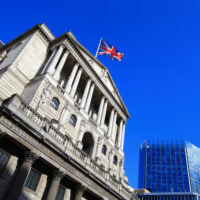
The Bank’s Monetary Policy Committee (MPC) voted by a 5-4 majority to maintain the base rate at 5.25 per cent. Four members preferred to increase it by 0.25 percentage points to 5.5 per cent.
The decision was based on forecasts suggesting that CPI inflation was expected to return to the 2% target by Q2 2025, and following yesterday’s latest inflation data showing a fall from 7.9 per cent in June to 6.7 per cent in August – 0.4 percentage points below the MPC’s expectations given last month.
However, the MPC noted risks that modal inflation forecasts were “skewed to the upside”, reflecting the possibility that the second-round effects of external cost shocks on inflation in wages and domestic prices may take longer to unwind than they did to emerge.
The MPC report stated: “CPI inflation is expected to fall significantly further in the near term, reflecting lower annual energy inflation, despite the renewed upward pressure from oil prices, and further declines in food and core goods price inflation. Services price inflation, however, is projected to remain elevated in the near term, with some potential month-to-month volatility.”
Indeed, annual private sector regular average weekly earnings growth increased to 8.1 per cent in the three months to July which is 0.8 percentage points above its August projection.
It added that spot oil prices have risen significantly, and UK GDP is estimated to have declined by 0.5 per cent in July. Elsewhere, there have been some further signs of a loosening in the labour market with a small rise in unemployment, although the market remains tight by historical standards.
What does this mean for borrowers?
Sarah Pennells, consumer finance specialist at Royal London, said: “After consecutive interest rate rises, this is a welcome pause for borrowers. Those on a tracker rate for their mortgage will doubtless be relieved that they will not see another rise in their repayment amounts.
“However, today’s decision by the Bank of England to leave the base rate at 5.25 per cent won’t help people whose current fixed rate mortgage is near its end, as they’re likely moving off a rate that was cheaper than the new fixed rate deals available. For some, these higher repayment amounts will be unaffordable or a huge stretch on their finances.”
Katie Brain, banking expert at business information and ratings firm Defaqto, noted that mortgage deals have become cheaper recently, with some fixed rate mortgage products falling below 5 per cent.
She noted that today, the best two-year fixed rate for a remortgage at 75 per cent LTV is 5.74 per cent with a £490 fee (First Direct) compared to the best rate on 1 September of 6.14 per cent with no fee.
The best five-year fixed rate is 4.99 per cent although there is a £1,495 fee (Yorkshire Building Society) compared to 5.23 per cent on 1 September with a fee of £1,395.
Meanwhile, Andrew Gall, head of savings and economics at the Building Societies Association, said for first-time buyers, the higher cost of a mortgage compared to two years ago, alongside the increased prices for energy, food and other items, “will have a considerable impact on what they can borrow”.
Gall said: “They may need to lower their ambitions about the property they would like to buy as they are unlikely to be able to borrow at the level they might have achieved before the Bank Rate started to rise in December 2021.”















